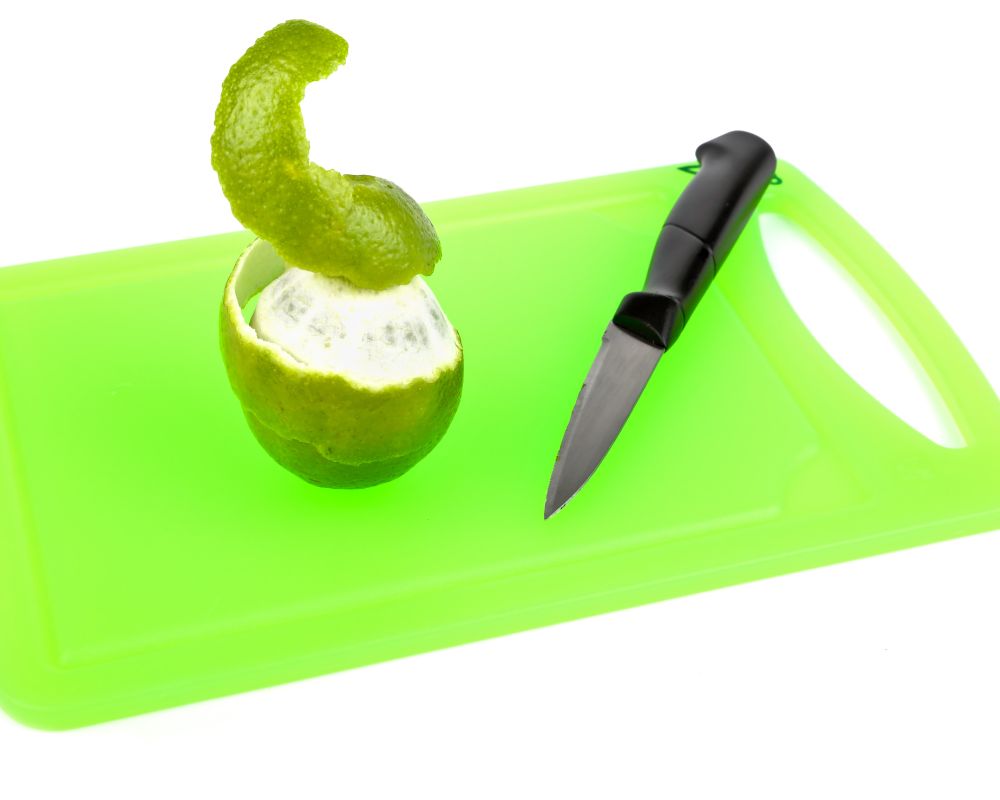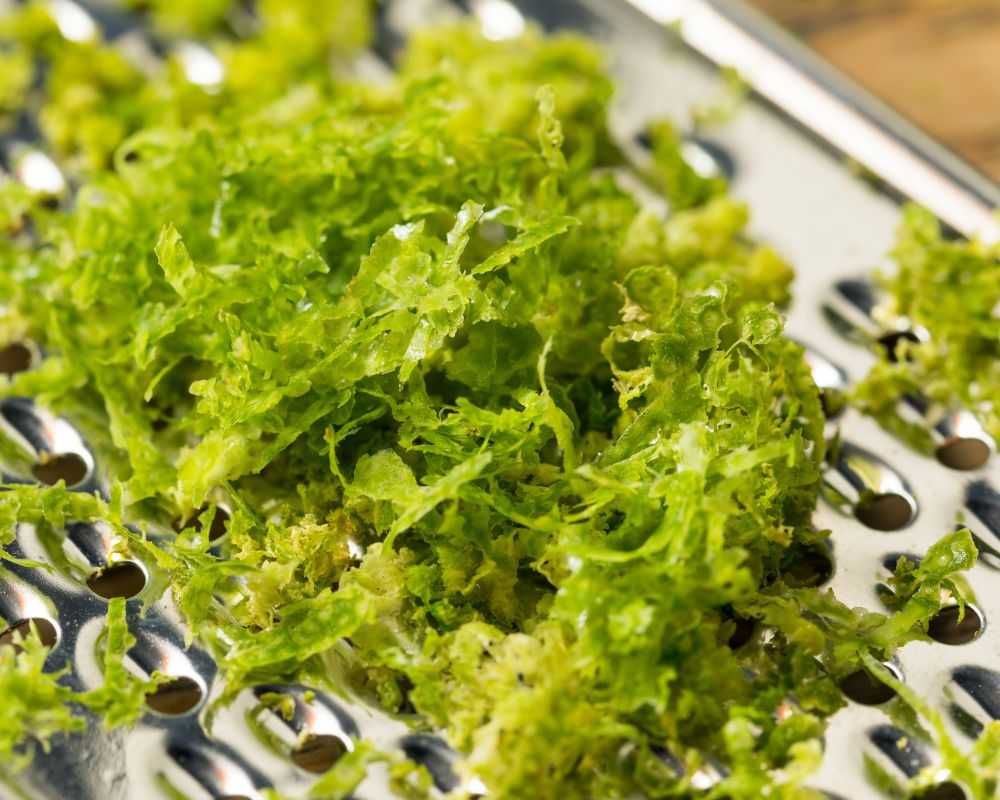Lime peel is the pithed outer skin removed from limes. The spice adds a slightly sweet, bitter lime flavor to baked goods, marinades, salsas, and cocktails. It's common in Caribbean, Latin American, Mediterranean, Mexican and Middle Eastern cuisines.
Table of Contents
What is a lime peel?

Lime peel is the entire green or yellow skin removed from limes by a vegetable peeler or sharp paring knife. It is the whole rind or zest, with the bitter white portion, called the pith.
Is lime peel edible?
Lime peel is edible and acts as a spice in different forms in various foods and drinks.
You can use it in the following forms:
- Fresh lime peel
- Dried lime peel (dehydrated lime peel)
- Lime peel powder
- Granulated lime peel (lime peel granules)
- Frozen lime peel
- Sugar-coated lime peel
| Appearance | Yellow or green, in stripes or diced, powdered or granulated |
| Flavor profile | Sweet, bitter, tangy |
| Dishes | Caribbean, Latin American, Mediterranean, Tex-Mex, Middle Eastern |
Appearance
Lime peel is usually made from yellow ripened limes. Green lime peel is also available from green limes but isn’t common because of its intense, unpleasant bitter flavor.
The texture of lime peel depends on its form and its intended purpose. All the forms start as round or circular fresh peels. These peels are then cut into thin strips or diced into large pieces.
The powdered and granulated lime peel comes from the dried peels ground to different degrees of fineness. Lime peel powder has a finer texture than lime peel granules.
Flavor profile
Lime peel has a slightly sweet, bitter flavor. It combines the slightly sweet citrus flavor of lime zest and the unpleasant bitter flavor of the white pith.
The spice gets its floral, tangy, sour, and tart aroma from the aromatic essential oils in the lime zest.
Dishes
The leading world producers of limes are India, China, Argentina, Mexico, and the US. While not all citrus limes are used to make lime peel, the spice is common in the following cuisines:
- Caribbean
- Latin American
- Mediterranean
- Middle Eastern
- Moroccan
- Tex-Mex
What is lime peel good for?

People use the lime peel for various purposes:
- To add a citrus flavor to dishes and baked goods
- To enrich a spice blend
- For marinades
- As a garnish
- As a substitute for other similar spices
- To infuse vinegar and olive oil
People use the lime peel to add a tart citrus flavor to various raw and cooked dishes. It effectively balances out salty, savory, spicy, and sweet flavors in cooked dishes.
You can use the lime peel to add a zesty, citrus fruit flavor to baked goods such as cakes, muffins, and cookies. For example, you can pulverize it with sugar to make lime cooler cookies.
Lime peel is in different spice blends, especially custom blends with cilantro and chili peppers. It blends well with chipotle peppers in chipotle-lime seasoning.
These spice blends are used as dry rubs or marinades for fish, chicken, and seafood. Chicken and seafood do well with marinades featuring lime peel, thyme, and garlic.
Powdered lime peel is excellent as a garnish over salads, drinks, salsas, and dressings. Circular peels are ideal for flavoring cocktails and hot beverages.
Granulated lime peel is a great addition to doughs for pizza, regular bread, and flatbreads like toasted pita bread. Add ground dried lime peel in citrus salt blends alongside orange peels or lemon zest.
The essential oils in lime zest make lime peel ideal for infusing vinegar and olive oil with a floral, citrusy aroma. Lime-infused vinegar cleans things and kills insects, while lime-infused olive oil serves to prepare various dishes.
Lime peel as a substitute
The lime peel works well as a substitute for other citrus fruit spices like:
- Orange peel
- Lemon peel
- Lemon pepper seasoning
- Lime juice
- Lemon powder
- Orange zest
- Lemon zest
- Grapefruit peel
Low-sodium dieters use the lime peel as a substitute for salt to add a sour, tart flavor to dishes.
Top 7 lime peel recipes
If you can’t wait to experience the flavor-balancing effect of lime peel spice, here are some recipes to try:
- A flavorful cocktail: April Rain Cocktail
- A hearty soup: Carrot, Lime, and Ginger Soup
- A mojito-like pie: Frozen Mojito Pie
- A tasty cheesecake: Key Lime Cheesecake
- A wonderful meat dish: Lamb Tagine
- An easy tea: Lemongrass-Lime Peel Tea
- Holiday cookies: Lime Cooler Cookies
How do you make lime peel?

It’s easy to make lime peel at home using readily available kitchen utensils and ripe, unwaxed limes. Here’s what to do:
- Select the best ripe limes. These should be firm and have a consistent yellow color.
- Wash the citrus fruits under cold running water to remove dirt, waxy coating, and pesticides.
- Use paper towels to pat the limes dry.
- Use a vegetable or sharp paring knife to cut circular peels with as much white pith as possible. (A vegetable Y-peeler creates oval peels suitable for garnishing cocktails.)
- Use a sharp knife to dice the peels into large pieces or slice them into thin strips. You can also leave them whole. You can use them at this point or proceed with the next steps for the dried lime peel.
- Dry the whole, diced, or sliced lemon peels to make a dried or dehydrated lime peel. Use a food dehydrator to dry the peels for 8-10 hours at 115°F until they are no longer flexible. Alternatively, dry them in an oven at the lowest temperature setting until they are curly and hardened.
- Once fully dried, remove the peels from the oven or food dehydrator and allow them to cool to room temperature.
- Place them in sealable airtight containers and condition them for a week to check for moisture and stickiness.
- If no moisture forms in the container, proceed with long-term storage in airtight containers like glass jars in a cool, dry, dark place.
- Use a food processor, blender, or coffee grinder to grind the dried peels into granules or powder.
Lime peel vs. lime zest


| Lime peel | Carries both the zest and the white pith, has an unpleasant, slightly bitter flavor |
| Lime zest | A part of lime peel, colored outer layer of the citrus skin, sweeter |
Although they come from the same citrus fruit, lime peel, and zest are different spices.
Lime zest is a part of lime peel. It is the colored outer layer of the citrus skin, which is grated off with a Microplane or zester. Lime peel carries both the zest and the white pith.
Because of the white pith, the lime peel has an unpleasant, slightly bitter flavor. The sweeter taste of lime zest rivals this.
Lime zest, freshly grated using a zester, has a fine texture but can be coarse if you use a vegetable peeler or paring knife. Lime peel has the same rough texture when freshly obtained using a peeler or knife.

